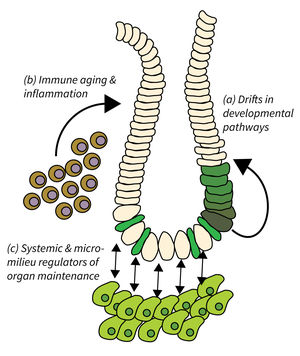Subarea 2: Regeneration and Homeostasis of Organs in Aging
The main goal of Subarea 2 is to identify cellular and molecular pathways used to ensure effective organ maintenance and repair, and to unravel the mechanisms of their deterioration during aging. While stem cells are important for organ homeostasis, this Subarea does not per se directly addresses stem cell aging but rather focusses on the following focus areas:
- Drifts in developmental pathways limiting organ maintenance in aging,
- Immune aging and inflammation, and
- Systemic and micro-milieu regulators of organ maintenance, regeneration, and disease development.
Research focus of Subarea 2
Organ maintenance is regulated by local and systemic factors, which are subject to aging-associated changes. Research of Subarea 2 focuses on the following research areas: a) Genetic and epigenetic modulation of developmental pathways has been shown to contribute to progressive aging and disease. It is critical to delineate mechanisms and consequences of aging-associated drifts to better understand organ maintenance during aging. b) Immunoaging and chronic inflammation elicits negative effects through reduced immune surveillance and aberrant organ repair and maintenance; all of which contributes to the evolution of organ pathologies and diseases during organismal aging. c) Furthermore, aging-associated alterations in systemic and extracellular factors derived from metabolic changes, microbiota alterations, chronic inflammation, senescent, or damaged cells might impinge on disease development and tumor initiation.
Publications
(since 2016)
2016
- NEMO Prevents RIP Kinase 1-Mediated Epithelial Cell Death and Chronic Intestinal Inflammation by NF-κB-Dependent and -Independent Functions.
Vlantis K, Wullaert A, Polykratis A, Kondylis V, Dannappel M, Schwarzer R, Welz P, Corona T, Walczak H, Weih F, Klein U, Kelliher M, Pasparakis M
Immunity 2016, 44(3), 553-67 - Classical and alternative NF-κB signaling cooperate in regulating adipocyte differentiation and function.
Weidemann A, Lovas A, Rauch A, Andreas N, von Maltzahn J, Riemann M, Weih F
Int J Obes Relat Metab Disord 2016, 40(3), 452-9 - Attenuated LKB1-SIK1 signaling promotes epithelial-mesenchymal transition and radioresistance of non-small cell lung cancer cells.
Yao YH, Cui Y, Qiu XN, Zhang LZ, Zhang W, Li H, Yu JM
Chin J Cancer 2016, 35(1), 50
2015
2008
- Large differences in aging phenotype between strains of the short-lived annual fish Nothobranchius furzeri.
Terzibasi* E, Valenzano* DR, Benedetti M, Roncaglia P, Cattaneo A, Domenici L, Cellerino A
PLoS One 2008, 3(12), e3866 * equal contribution
2007
- Neurophysiological correlates for the perception of facial sexual dimorphism.
Cellerino A, Borghetti D, Valenzano DR, Tartarelli G, Mennucci A, Murri L, Sartucci F
Brain Res Bull 2007, 71(5), 515-22 published during change of institution - The short-lived fish Nothobranchius furzeri as a new model system for aging studies.
Terzibasi E, Valenzano DR, Cellerino A
Exp Gerontol 2007, 42(1-2), 81-9 published during change of institution
2006
- Resveratrol and the pharmacology of aging: a new vertebrate model to validate an old molecule.
Valenzano DR, Cellerino A
Cell Cycle 2006, 5(10), 1027-32 published during change of institution









